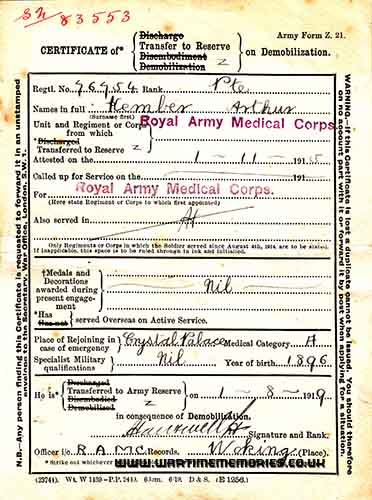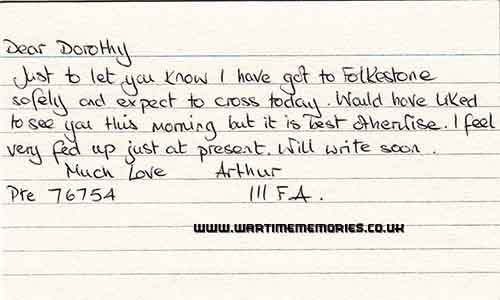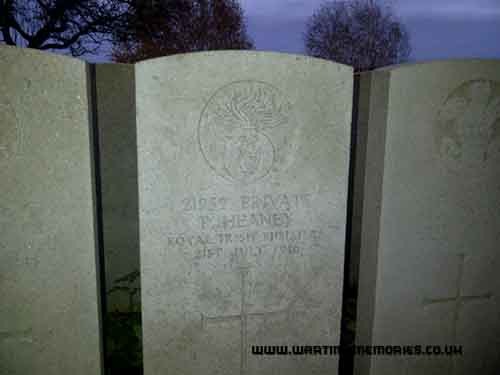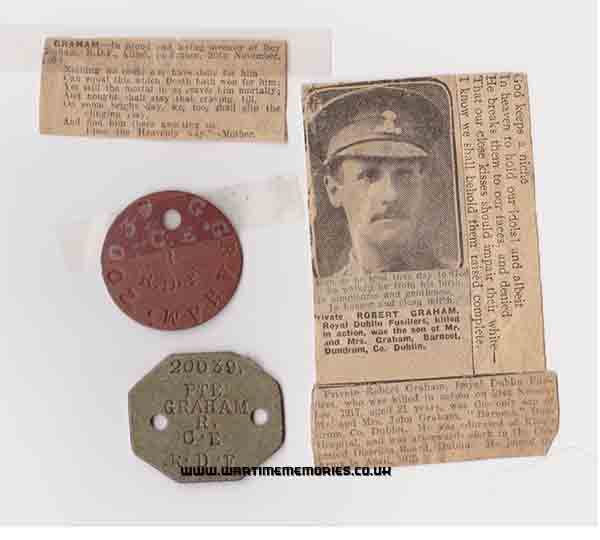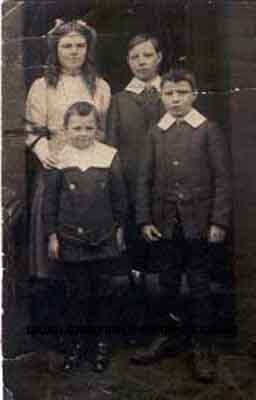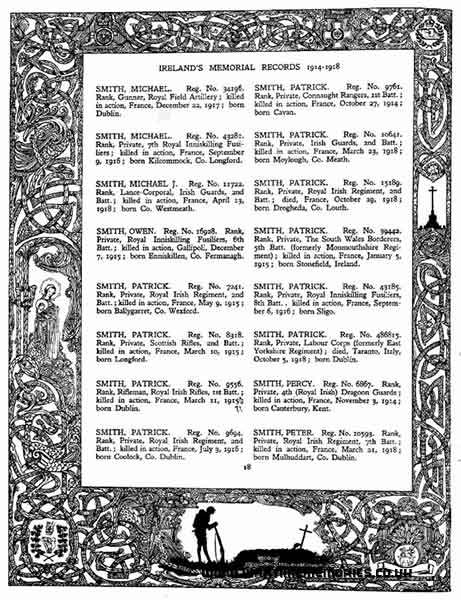|
|
|
16th (Irish) Division
16th (Irish) Division was established by the Irish Command in September 1914, as part of the Army Orders authorising Kitchener's Second New Army, K2. Early days were somewhat chaotic, the new volunteers having very few trained officers and NCOs to command them, no organised billets or equipment. The Division moved to England and into barracks in Aldershot by the end of the month.
The training and preparation of the Division was slowed by the loss of many of its units to the 37th and Guards Divisions when they were created in 1915.
In December 1915 the Division moved to France and concentrated in the Bethune area. It served on the Western Front with distinction throughout the war.
1916
- The Battle of Guillemont - Somme in which the Division captured the village
- The Battle of Ginchy - Somme
1917
- The Battle of Messines
- The Battle of Langemark
1918
- The Battle of St Quentin - Somme
- The Battle of Rosieres - Somme
On the 18th of June 1918 after suffering very heavy casualties a decision was taken to return the Division to England for refit and it was then significantly reconstituted. The Division lost virtually all of its remaining Irish units at this point.
They returned to France on the 1st of August 1918 and took part in the Final Advance in Artois.
The Division suffered the loss of more than 28,000 casualties during the war.
Order of Battle of the 16th (Irish) Division
47th Brigade
- 6th Btn, Royal Irish Regiment disbanded 9 February 1918. Troops were redeployed to 2nd and 7th Royal Irish Regiment
- 6th Btn, Connaught Rangers reduced to cadre 13 April 1918. Troops were redeployed to 2nd Leinster, left June 1918
- 7th Btn, Leinster Regiment disbanded 14 February 1918. Troops went to 2nd Btn and to 19th Entrenching Bn,
- 8th Btn, the Royal Munster Fusiliers absorbed by 1st Btn of the regiment on 23 November 1916
- 47th Machine Gun Company MGC joined 28 April 1916, moved to 16th Battalion MGC 9 March 1918
- 47th Trench Mortar Battery formed by 16 June 1916, reformed in England 1918
- 1st Btn, Royal Munster Fusiliers joined 22 November 1916, left 20 April 1918
- 2nd Btn, Leinster Regiment joined 2 February 1918, left 23 April 1918
- 14th Btn, Leicestershire Regiment joined 26 June 1918, after absorbing 2/4th Btn of the regiment
- 6/7th Btn, Royal Scots Fusiliers joined as a cadre June 1918, left July 1918
- 9th Btn, Black Watch joined 2 July 1918 after absorbing 15th Btn of the regiment
- 18th Btn, Welsh Regiment joined 7 July 1918 after absorbing 25th Btn of the regiment
48th Brigade
- 7th Btn, Royal Irish Rifles left 23 August 1917
- 9th Btn, Royal Munster Fusiliers disbanded 30 May 1916. Troops deployed to 1st, 2nd and 8th Bns of the regiment
- 8th Btn, Royal Dublin Fusiliers merged and became 8/9th Bn 24 October 1917. Surplus troops went to 10th Btn. Disbanded 10 February 1918, troops went to 1st Btn
- 9th Btn, Royal Dublin Fusiliers amalgamated into 8/9 Btn 24 October 1917
- 48th Machine Gun Company MGC joined 28 April 1916, moved to 16th Battalion MGC 9 March 1918
- 1st Btn, Royal Munster Fusiliers joined 28 May 1916, left 22 November 1916
- 48th Trench Mortar Battery formed by 24 June 1916, reformed in England 1918
- 2nd Btn, Royal Dublin Fusiliers joined 16 November 1916, amalgamated with 1st Btn 14 April 1918. 2nd Btn was then reformed as a training cadre. Left 1 June 1918
- 1st Btn, Royal Dublin Fusiliers joined 19 October 1917, amalgamated with 2nd Btn 14 April 1918. Left 26 April 1918
- 2nd Btn, Royal Munster Fusiliers joined 3 February 1918, left as cadre 19 May 1918, surplus troops going to 1st Btn. Left 31 May 1918
- 22nd Btn, Northumberland Fusiliers joined 2 July 1918, after absorbing 38th NF.
- 18th Btn, Cameronians (Scottish Rifles) joined 2 July 1918
- 11th Bn, the Royal Irish Fusiliers joined 10 June 1918, absorbed by 5th Bn 29 August 1918
- 5th Btn, Royal Irish Fusiliers joined 24 August 1918
- 10th Btn, Royal Dublin Fusiliers joined 23 June 1917, left 13 February 1918. Disbanded two days later and troops went to 19th Entrenching Bn
49th Brigade
- 7th Btn, Royal Irish Fusiliers amalgamated with 8th Btn 15 October 1916 and became 7/8th Btn. Disbanded 10 February 1918, troops going to 1st and 9th Btns
- 8th Btn, Royal Irish Fusiliers amalgamated with 8th Btn 15 October 1916 and became 7/8th Btn
- 7th Btn, Royal Inniskilling Fusiliers amalgamated with 8th Bn 23 August 1917 and became 7/8th Btn. Reduced to cadre 22 April 1918, surplus troops to 2nd Royal Irish Regiment. Cadre left 17 June 1918
- 8th Btn, Royal Inniskilling Fusiliers joined October 1914, amalgamated with 7th Btn 23 August 1917
- 49th Machine Gun Company MGC joined 29 April 1916, moved to 16th Battalion MGC 9 March 1918
- 49th Trench Mortar Battery formed by 16 June 1916, reformed in England 1918
- 2nd Btn, Royal Irish Regiment joined 14 October 1916, left 23 April 1918
- 7th Btn, Royal Irish Regiment joined 14 October 1917, reduced to cadre 18 April 1918. Left 17 June 1918
- 34th Btn, London Regiment joined 27 June 1918
- 7th Btn, King's Royal Rifle Corps joined as a cadre June 1918, absorbed by 34th London Regiment in same month
- 5th Btn, Ox & Bucks Light Infantry joined as a cadre June 1918, absorbed by 18th Gloucesters in same month
- 13th Btn, Duke of Cornwall's Light Infantry joined as a cadre June 1918, absorbed by 6th Somersets in same month
- 7th Btn, Royal Dublin Fusiliers joined as a cadre June 1918, absorbed by 11th Royal Irish Fusiliers in same month
- 6/7th Btn, Royal Scots Fusiliers joined as a cadre June 1918, absorbed by 18th Scottish Rifles in same month
- 18th Btn, the Gloucestershire Regiment joined 2 July 1918
- 6th Btn, the Somerset Light Infantry joined 4 July 1918
Divisional Troops
- 11th Btn, Hampshire Regiment joined 20 September 1914. Absorbed many troops of 13th Btn, Border Regiment in June 1918
- 269th Machine Gun Company MGC joined 18 January 1918, moved to 16th Battalion MGC 9 March 1918
- 16th Machine Gun Battalion MGC formed 9 March 1918. Broken up at Camiers on 8 May 1918 and troops transferred to infantry. A new Bn was formed at Grantham on 18 June 1918 and joined the Division on 2 August 1918
- 19th Entrenching Battalion joined 4 April 1918, disbanded 5 May 1918. Troops went to 2nd Royal Munster Fusiliers
Divisional Mounted Troops
- 16th Divisional Cyclist Company joined 11 December 1914, disbanded 1 June 1916. Troops redeployed to the infantry
- C Squadron, South Irish Horse joined January 1915, left 17 May 1916
Divisional Artillery
- LXXIV Brigade RFA left in July 1915 to join Guards Division
- LXXV Brigade RFA left in July 1915 to join Guards Division
- LXXVI Brigade RFA left in July 1915 to join Guards Division
- LXXVII (H) Brigade RFA left in July 1915 but rejoined in France 22nd of February 1916, left 22nd of February 1917
- CLXXVII Brigade RFA joined in France on 22nd of February 1916
- CLXXX Brigade RFA joined in France on 22nd of February 1916
- CLXXXII Brigade RFA joined in France on 22nd of February 1916. Broken up on 27th of August 1916
- 16th Divisional Ammunition Column RFA the original DAC left in August 1915 to join Guards Division. A new DAC joined Division in France on 22nd of February 1916
- 16th Heavy Battery RGA raised for the Division but moved independently to France in July 1915
- X.16, Y.16 and Z.16 Medium Trench Mortar Batteries RFA joined by June 1916. Z.16 broken up 27 February 1918. X.16 and Y.16 broken up 20 April 1918, troops being absorbed by other units
- V.16 Heavy Trench Mortar Battery RFA joined by 5 September 1916, left February 1918
Royal Engineers
- 75th Field Company left 13 August 1915 to join Guards Division
- 76th Field Company left 13 August 1915 to join Guards Division
- 16th Divisional Signal Company left 13 August 1915 to join Guards Division. A new Company joined in September 1915
- 95th Field Company joined 30 January 1915 from 26th Division, left 17 August 1915 to join 7th Division
- 155th Field Company joined in August 1915
- 156th Field Company joined in August 1915
- 157th Field Company joined in August 1915
Royal Army Medical Corps
- 48th Field Ambulance left June 1915 and joined 37th Division
- 49th Field Ambulance left June 1915 and joined 37th Division
- 50th Field Ambulance left June 1915 and joined 37th Division
- 111th Field Ambulance joined September 1915
- 112th Field Ambulance joined September 1915
- 113th Field Ambulance joined September 1915
- 81st Sanitary Section joined before embarkation, left for IX Corps in April 1917
Other Divisional Troops
- 16th Divisional Train ASC 142, 143, 144 and 145 Companies
- 16th Divisional Motor Ambulance Workshop joined 25 December 1915 from
- Lahore Division. Absorbed into Divisional Train by 9 April 1916
- 217th Divisional Employment Company formed by 30 June 1917
- 47th Mobile Veterinary Section AVC
Jun 1915 On the Move
Jul 1915 Training Instruction
Jul 1915 Billets
11th Dec 1915 Orders
12th Dec 1915 Advance Party
19th Dec 1915 On the March
20th Dec 1915 On the Move
21st Dec 1915 On the Move
22nd Dec 1915 On the March
27th Dec 1915 Poor Conditions
28th Dec 1915 On the March
30th Dec 1915 Orders Received
31st Dec 1915 Inspection
3rd Feb 1916 Orders Received
17th Feb 1916 On the Move
18th Feb 1916 On the Move
19th Feb 1916 On the Move
20th Feb 1916 On the Move
21st Feb 1916 On the Move
22nd Feb 1916 On the March
2nd March 1916 In Billets
20th Apr 1916 Reliefs
24th Apr 1916 Reliefs 
26th Apr 1916 In Billets 
27th Apr 1916 On the Move
27th Apr 1916 Gas 
27th April 1916 Received Orders to "Stand To"
28th Apr 1916 On the Move 
28th Apr 1916 Reliefs
29th Apr 1916 On the Move 
29th Apr 1916 Reliefs
29th April 1916 Heavy bombardment at Quarries.
30th Apr 1916 Recce 
1st May 1916 Instruction 
2nd May 1916 HQ Moves 
3rd May 1916 Reliefs 
7th May 1916 Reliefs 
8th May 1916 Reliefs 
13th May 1916 Reliefs 
16th May 1916 Reliefs 
17th May 1916 Reliefs 
21st May 1916 Reliefs
24th May 1916 Reliefs 
28th May 1916 Trench Recce
1st Jun 1916 Emplacements 
2nd Jun 1916 Emplacements 
3rd Jun 1916 Night Firing 
4th Jun 1916 Night Firing 
5th Jun 1916 Working Party 
6th Jun 1916 Heavy Shelling 
7th Jun 1916 Working Parties 
8th Jun 1916 Wet Weather 
9th Jun 1916 Reliefs 
15th Jun 1916 Quiet 
16th Jun 1916 Reliefs 
17th Jun 1916 Night Firing 
18th Jun 1916 Night Firing 
19th Jun 1916 Emplacements 
20th Jun 1916 Heavy Shelling 
21st Jun 1916 Emplacements 
22nd Jun 1916 Working Parties 
23rd Jun 1916 Bombardment 
24th Jun 1916 Night Firing 
25th Jun 1916 Heavy Shelling 
26th Jun 1916 Raid 
27th Jun 1916 Repairs 
28th Jun 1916 Gas 
29th Jun 1916 Night Firing 
30th Jun 1916 Attack 
1st Jul 1916 Report 
1st Jul 1916 Report 
1st Jul 1916 Attack 
2nd Jul 1916 Artillery 
7th July 1916 On the March
11th July 1916 Heavy Bombardment
20th Jul 1916 Orders 
20th July 1916 Message
23rd August 1916 Operational Orders from Brigade
28th of August 1916 Hostile Fire 
1st of September 1916 Enemy SOS 
1st Sep 1916 In Reserve 
2nd Sep 1916 Orders 
3rd Sep 1916 Wounded Treated On the 3rd of September 1916, the 62nd Field Ambulance RAMC was involved in the Battle of Guillemont retrieving and treating wounded soldiers from the battlefield very close to where the enemy were firing an incessant hail of bullets and shells. This was during the decisive Allied attack on the German-held strong hold of Guillemont. 62nd Field Ambulance were operating under the command of British 20th (Light) Division which operated in unison with the 47 Brigade of the 16th (Irish) Division and together other forces they succeeded in capturing Guillemont on that day. 62nd Field Ambulance had been involved in this battle for many months prior the victory on 3rd September, operating in the so-called 'Valley of Death' which the Germans sprayed with machine-gun fire, bombs and gas-shells from their vantage point with great loss of life to Allied forces.
3rd Sep 1916 On the March 
4th of September 1916 Units Mixed Up 
4th Sep 1916 Orders 
5th Sep 1916 Lost
5th of September 1916 Farm Captured 
5th Sep 1916 Reliefs 
6th Sep 1916 Patrols
6th of September 1916 Wood Cleared 
6th Sep 1916 Consolidation 
7th Sep 1916 Line Consolidated 
8th of September 1916 Prepare to Move
8th Sep 1916 Reserve 
9th Sep 1916 In Action 
9th Sep 1916 Bombardment 
10th Sep 1916 Reliefs 
1st of October 1916 Relieving the Canadians 
6th Oct 1916 Enemy Active 
29th of October 1916 Raid Support 
5th of December 1916 Spranbroek Group Formed
5th of December 1916 
1st Jan 1917 Artillery Active 
2nd Jan 1917 Night Firing 
3rd Jan 1917 Reliefs 
4th Jan 1917 Artillery Active 
5th Jan 1917 Artillery in Action 
6th Jan 1917 Night Firing 
7th Jan 1917 Bombardment 
8th Jan 1917 Heavy Shelling 
9th Jan 1917 Intermittent Shelling 
10th Jan 1917 Shelling 
11th Jan 1917 Night Firing 
12th Jan 1917 Artillery Active 
13th Jan 1917 Poor Conditions 
14th Jan 1917 Frost 
15th Jan 1917 Night Firing 
16th Jan 1917 Night Firing 
17th Jan 1917 Reliefs 
18th Jan 1917 Night Firing 
19th Jan 1917 Artillery Active 
20th Jan 1917 Night Firing 
21st Jan 1917 Accident 
22nd Jan 1917 Artillery AIn Action 
23rd Jan 1917 Night Firing 
24th Jan 1917 Reliefs 
25th Jan 1917 Night Firing 
26th Jan 1917 Artillery Active 
27th Jan 1917 Artillery Active 
28th Jan 1917 Night Firing 
29th Jan 1917 Shelling 
30th Jan 1917 Artillery in Action 
31st Jan 1917 Night Firing 
19th of February 1917 Divisional Cooperation
1st Mar 1917 Trench Raid 
2nd Mar 1917 Trench Raid 
3rd Mar 1917 Trench Work 
4th Mar 1917 Working Party 
5th Mar 1917 Reliefs 
1st May 1917 Reliefs 
5th May 1917 Reliefs 
7th May 1917 Bombardment 
9th May 1917 Bombardment 
10th May 1917 Reliefs 
14th May 1917 Reliefs 
18th May 1917 Working Parties 
24th May 1917 Relocation in new camp
1st of June 1917 Instructions for the Offensive 
1st June 1917 In Reserve
1st Jun 1917 Cleaning up
2nd June 1917 Reliefs 
2nd Jun 1917 Reliefs
3rd June 1917 Artillery in Action 
3rd Jun 1917 Bombardment 
4th June 1917 Reliefs 
4th Jun 1917 Emplacements 
5th June 1917 Trench Raid 
5th Jun 1917 Preparations 
6th June 1917 Reliefs 
6th Jun 1917 Preparations 
7th of June 1917 An Offensive Operation 
7th of June 1917 Attack a Complete Success 
7th June 1917 In Action
7th Jun 1917 In Action 
8th June 1917 At Rest 
8th Jun 1917 Reliefs 
9th June 1917 Into Camp 
9th Jun 1917 Reliefs 
10th June 1917 Working Parties 
28th of July 1917 Orders for an Attack 
2nd of August 1917 More Orders Received 
14th of August 1917 Practice Barrages 
15th of August 1917 Thirty Hostile Planes 
25th of August 1917
1st of September 1917
7th of September 1917 Orders
1st of October 1917 Positions 
14th Oct 1917 On the Move
15th Oct 1917 Training
16th Oct 1917 Training
17th Oct 1917 Training
18th Oct 1917 Training
19th Oct 1917 Inspection
20th Oct 1917 Training
21st Oct 1917 Church Parade
22nd Oct 1917 Divisional Reliefs 
23rd Oct 1917 Working Parties 
24th Oct 1917 Working Parties 
25th Oct 1917 Dugouts 
26th Oct 1917 Dugouts 
27th Oct 1917 Dugouts 
28th Oct 1917 Relief Complete 
29th Oct 1917 Trench Raid 
30th Oct 1917 Recce 
31st Oct 1917 Trench Work 
1st Nov 1917 Reliefs 
2nd Nov 1917 In Camp
3rd Nov 1917 In Camp
4th Nov 1917 Inspection
5th Nov 1917 Training
6th Nov 1917 Training
7th Nov 1917 Training
8th Nov 1917 Training
9th Nov 1917 Training
10th Nov 1917 Training
11th Nov 1917 Church Parade
12th Nov 1917 Reliefs 
13th Nov 1917 Trench Work 
14th Nov 1917 Machine Guns 
15th Nov 1917 Quiet 
16th Nov 1917 Patrols 
17th Nov 1917 Quiet 
18th Nov 1917 Machine Guns Active 
19th Nov 1917 Trench Work 
20th Nov 1917 Attack Made
20th Nov 1917 Artillery In Action 
21st Nov 1917 Shelling 
22nd Nov 1917 Trench Work 
23rd Nov 1917 Shelling 
24th Nov 1917 Shelling 
25th Nov 1917 Reliefs 
26th Nov 1917 Equipment
27th Nov 1917 Baths
28th Nov 1917 Inspection
29th Nov 1917 Training
30th Nov 1917 Reliefs 
1st Dec 1917 In the Line 
2nd Dec 1917 Reliefs 
3rd Dec 1917 On the March
4th Dec 1917 Stand to
5th Dec 1917 On the March
6th Dec 1917 On the March
7th Dec 1917 Reliefs Complete
8th Dec 1917 Quiet
9th Dec 1917 Trench Work
10th Dec 1917 Enemy Sighted
11th Dec 1917 Artillery Active
12th Dec 1917 Relief Complete
13th Dec 1917 In Bivouacs
14th Dec 1917 Working Party
15th Dec 1917 Working Party
16th Dec 1917 Equipment
17th Dec 1917 Relief Complete
18th Dec 1917 In Billets
19th Dec 1917 On the March
20th Dec 1917 In Billets
21st Dec 1917 In Billets
22nd Dec 1917 Recce
23rd Dec 1917 Relief
24th Dec 1917 Shelling
24th Dec 1917 Reorganisation
25th Dec 1917 Shelling
26th Dec 1917 Enemy Aircraft
27th Dec 1917 Snow
28th Dec 1917 Enemy Aircraft
29th Dec 1917 Reliefs
30th Dec 1917 Working Parties
31st Dec 1917 Working Parties
31st December 1917 Operational Orders
1st Jan 1918 Shelling
2nd Jan 1918 Heavy Shelling
3rd Jan 1918 Aircraft Active
4th Jan 1918 Reliefs
5th Jan 1918 Baths
6th Jan 1918 Wiring
7th Jan 1918 Festivities
8th Jan 1918 Training
9th Jan 1918 Training
10th Jan 1918 Reliefs
11th Jan 1918 Patrol
12th Jan 1918 Patrols
13th Jan 1918 Shelling
14th Jan 1918 Artillery Active
15th Jan 1918 Artillery Active
16th Jan 1918 Thaw
17th Jan 1918 Working Parties
18th Jan 1918 Working Parties
19th Jan 1918 Working Parties
20th Jan 1918 Church Parade
21st Jan 1918 Working Parties
21st Jan 1918 Course
22nd Jan 1918 Reliefs
23rd Jan 1918 Patrol
24th Jan 1918 Poor Visibility
25th Jan 1918 Fog 
25th Jan 1918 Heavy Shelling
26th Jan 1918 Poor Visibility
27th Jan 1918 Mist
28th Jan 1918 Reliefs
29th Jan 1918 Working Parties
30th Jan 1918 Working Parties
31st Jan 1918 Fog
1st Feb 1918 Shelling
2nd Feb 1918 Cross Roads
3rd Feb 1918 Reliefs
4th Feb 1918 Cleaning up
5th Feb 1918 Football
5th Feb 1918 Course Ends
6th Feb 1918 Musketry
7th Feb 1918 Awards
8th Feb 1918 Training
9th Feb 1918 Training
10th Feb 1918 Reorganisation
11th Feb 1918 Working Party
12th Feb 1918 Training
13th Feb 1918 Training
13th Feb 1918 Personnel
14th Feb 1918 Reliefs
15th Feb 1918 Patrols
16th Feb 1918 Working Party
17th Feb 1918 Enemy Aircraft
18th Feb 1918 Air Raid
19th Feb 1918 Patrols
20th Feb 1918 Patrols
21st Feb 1918 Bombardment
21st Feb 1918 Reorganisation
22nd Feb 1918 Bombardment
23rd Feb 1918 Defences
24th Feb 1918 Shelling
25th Feb 1918 Shelling
26th Feb 1918 Reliefs
27th Feb 1918 Patrols
28th Feb 1918 Shelling
1st Mar 1918 Holding the Line
5th Mar 1918 Holding the Line
9th Mar 1918 Holding the Line
10th Mar 1918 In the trenches
12th Mar 1918 Reliefs
13th Mar 1918 In Reserve
14th Mar 1918 Attack Expected 
18th Mar 1918 Reliefs
19th Mar 1918 Holding the Line 
20th Mar 1918 Holding the Line 
22nd Mar 1918 Fighting Retreat
22nd of March 1918 Message
23rd Mar 1918 Fighting Retreat
24th Mar 1918 In Defence
25th Mar 1918 In Defence
26th Mar 1918 In Defence
27th Mar 1918 Fighting Withdrawal
28th Mar 1918 Holding the Line
29th Mar 1918 Holding the Line
30th Mar 1918 Holding the Line
31st Mar 1918 Holding the Line
1st Apr 1918 Holding the Line
2nd Apr 1918 Holding the Line
3rd Apr 1918 Holding the Line
4th Apr 1918 Reliefs
5th Apr 1918 On the March
8th Apr 1918 Reorganisation
9th Apr 1918 On the March
10th Apr 1918 On the Move
11th Apr 1918 On the March
12th Apr 1918 On the March
13th Apr 1918 Reorganisation
14th Apr 1918 On the March
15th Apr 1918 On the March
16th Apr 1918 Working Parties
17th Apr 1918 Working Parties
18th Apr 1918 Reorganisation
17th May 1918 22nd Northumberlands join 16th Division On the 17th May 1918 the 22nd Northumberlands were reduced to cadre strength and transferred to the 16th (Irish) Division.
18th May 1918 On the Move 22nd Northumberland Fusiliers return to England.
18th Jun 1918 22nd Northumberlands back to strength The 22nd Northumberland Fusiliers are brought up to strength by absorbing the 38th Btn.
Jul 1918 22nd Northumberlands return to France 22nd Battalion, Northumberland Fusiliers return to France with 16th (Irish) Division.
1st September 1918 Move to Front Line
2nd September 1918 Night patrols
3rd September 1918 Ongoing Action
6th September 1918 Attack on enemy lines 22nd Battalion, Northumberland Fusiliers
6th Sep. 1918 - 0630 We attacked with three companies from left to right A, D and C Companies without artillery preparation.The ground was very difficult with wire lying about. The weather was perfect with a slight mist. We gained all our objectives with A Company finding the most resistance however they got beyond their objectives and did very well. After the attack the enemy shelled our new posts very heavily.
Casualties during attack 5th to 7th September.
- 2nd Lt GO Mitchell wounded
- 34 Other Ranks wounded (gas)
- 1 Other Rank died of wounds
- 6 Other Ranks wounded
- 11 Other Ranks missing
- 5 Other Ranks killed
- 24 Other Ranks wounded
- 2nd Lt JF Punsham wounded (gas)
- 27 Other Ranks wounded
- 4 Other Ranks killed
7th September
Enemy continued shelling our new lines.
8th September
The Battalion was relieved by the 18th Gloucester Regiment and moved back to Village Line as Support Battalion, while the 18th Gloucesters continued to push forward.
war diaries
5th of October 1918 Orders 
10th of October 1918
19th October 1918 Met with opposition at Rupilly Etieu 
If you can provide any additional information, please add it here.
|
|
|
Want to know more about 16th (Irish) Division? There are:372 items tagged 16th (Irish) Division available in our Library There are:372 items tagged 16th (Irish) Division available in our Library 
These include information on officers, regimental histories, letters, diary entries, personal accounts and information about actions during the Great War.
|
|
Those known to have served with16th (Irish) Division during the Great War 1914-1918. - Andrews Patrick. Pte. 8th Btn. (d.29th Apr 1916)
- Arnold T.. Pte. 5th Btn. (d.30th Sep 1918)
- Atock Arthur George. Lt. 155th Field Coy. (d.13th Sep 1918)
- Attley William. Sgt. 2nd Btn. (d.31st Oct 1916)
- Authors Charles. L/Cpl. 9th Btn. (d.23rd Jul 1916)
- Bailey Edward. Sgt. 7th Btn. (d.16th Aug 1917)
- Baker Christopher. L/Cpl. 9th Btn. (d.16th Aug 1917)
- Beggs Joseph. Pte. 8th Btn. (d.6th Sep 1916)
- Connolly Patrick. Pte. 8th Btn.
- Cox John Thomas. Sgt.
- Craddock Michael. Pte. 7th Btn. (d.7th Sep 1916)
- Doyle William Joseph Gabriel. Capt. att. 8th Btn. Royal Irish Fusiliers (d.16th Aug 1917)
- Eglington Thomas. Pte. 2nd Btn. (d.7th Aug 1917)
- Fitzpatrick Alexander. Pte. 7th/8th Btn. (d.10th Aug 1917)
- Graham Robert. Pte. 2nd Btn. (d.21st Nov 1917)
- Heaney Patrick. Pte. 8th Btn. (d.21st Jul 1916)
- Keane William. 2ndLt. 7th Btn.
- Kearns Michael L.. Pte. 7th Btn.
- Kelly John. Pte. 7th Battalion (d.22nd Aug 1918)
- Kember Arthur. Pte.
- Laverty John. L/Cpl. 7/8th Btn. (d.20th Nov 1917)
- Litton M.. Major. 7th Btn.
- McKee Patrick. Pte. 7/8th Btn. (d.20th Nov 1917)
- Potts Alfred James. Pte. 10th Btn.
- Savage Frederick William. Pte. 1st Btn.
- Slator John J. Sgt. 7th/8th Btn.
- Smith Michael. Pte. 7th Btn. (d.9th Sep 1916)
- Smith Patrick. Pte. 7th Btn.
- Smith Patrick. Pte. 7/8th Btn.
- Smith Patrick. Pte. 7/8th Btn.
- Wright Norman. L/Cpl. 22nd Btn. (d.4th Oct 1918)
All names on this list have been submitted by relatives, friends, neighbours and others who wish to remember them, if you have any names to add or any recollections or photos of those listed,
please Add a Name to this List
|
|
The Wartime Memories Project is the original WW1 and WW2 commemoration website.

- 1st of September 2024 marks 25 years since the launch of the Wartime Memories Project. Thanks to everyone who has supported us over this time.
|
Want to find out more about your relative's service? Want to know what life was like during the Great War? Our
Library contains many many diary entries, personal letters and other documents, most transcribed into plain text.
|
Looking for help with Family History Research?
Please see Family History FAQ's
Please note: We are unable to provide individual research.
|
|
Can you help?
The free to access section of The Wartime Memories Project website is run by volunteers and funded by donations from our visitors.
If the information here has been helpful or you have enjoyed reaching the stories please conside making a donation, no matter how small, would be much appreciated, annually we need to raise enough funds to pay for our web hosting or this site will vanish from the web.
If you enjoy this site
please consider making a donation.
Announcements
- 19th Nov 2024
Please note we currently have a massive backlog of submitted material, our volunteers are working through this as quickly as possible and all names, stories and photos will be added to the site. If you have already submitted a story to the site and your UID reference number is higher than
264989 your submission is still in the queue, please do not resubmit.
Wanted: Digital copies of Group photographs, Scrapbooks, Autograph books, photo albums, newspaper clippings, letters, postcards and ephemera relating to the Great War. If you have any unwanted
photographs, documents or items from the First or Second World War, please do not destroy them. The Wartime Memories Project will give them a good home and ensure that they are used for educational purposes. Please get in touch for the postal address, do not sent them to our PO Box as packages are not accepted.
|
World War 1 One ww1 wwII greatwar great battalion regiment artillery
Did you know? We also have a section on World War Two. and a
Timecapsule to preserve stories from other conflicts for future generations.
|
|
|
263024 Pte. Patrick Smith 7/8th Btn. Royal Irish Fusiliers I have a hospital receipt from Queen Mary's Hospital showing Patrick Smith arrived at the hospital on 19th of August 1917. I'm trying to determine what the cause of wounds was. He recovered after 9 months and was transferred to the Reserve units back in Ireland.
|
262231 Pte. Patrick Smith 7/8th Btn. Royal Irish Fusiliers Patrick Smith served with the 7/8th Battalion, Royal Irish Fusiliers. I have a receipt acknowledging him as having been received on 19th of August 1917 by Queen Mary's Military Hospital. His unit fought in 3rd Ypres and suffered 224 casualties on 16th of August 1917, and I presume he was wounded in that action. The cause and extent of his injuries are unknown, but he did recover and was transferred approximately 9 months later to the 200th Company, Royal Defence Corps, where he served out the rest of the war.
|
262143 Pte. Patrick Smith 7th Btn. Royal Irish Fusiliers Patrick Smith landed in France as part of the BEF on 17th of February 1916, serving until 18th of August 1917 when he was evacuated to Queen Mary’s Military Hospital in Whalley, Lancashire on 19th of August 1917. He was subsequently transferred to the Royal Defence Corps and promoted to Lance Corporal in 1918. He was discharged 19th of March 1919, whereupon he returned to Cavan and lived out the rest of his days there.
|
255929 Sgt. John Thomas Cox DCM. Connaught Rangers John Cox was awarded the DCM for actions on The Somme.
|
246289 Sgt. John J Slator 7th/8th Btn. Royal Inniskilling Fusiliers Jack Slator served with the 7th/8th Battalion, Royal Inniskilling Fusiliers. He was a Prisoner of War, POW no. 21920
|
243614 Pte. Frederick William Savage MM & Bar. 1st Btn. Royal Munster Fusiliers  Frederick Savage was on the S.S. River Clyde at Gallipoli V Beach landing and was amongst the first to go ashore where he survived unhurt. He was present for virtually all of the campaign being wounded twice and suffering severe frostbite. The second wound was towards the end of the campaign when he was hit in the back by a bullet whilst lying in prone position. He always blamed the fact that they wore a polished metal disc on their backpacks, which caught the sun's rays giving the Turks a good target to aim at. When wounded he was placed in a tent near the beach with the other wounded. The weather turned very cold. They were in the tent for several days without much nursing attention resulting in him being the only survivor. He returned to his regiment in France in June 1916 and served out most of the war. He was awarded the Military Medal for attending the wounded under heavy shell fire and also received two Hickies Medals, one in November 1916 and the other in November 1917. He served in the Home Guard during WW2.
Private F.W. Savage, M.M., collected two 'Hickie citations' during his service in France.
Major-General Hickie appreciated the effort put in by the men of the 16th Irish Division in the heavy fighting of 1916.
When no official recognition of gallantry was made, he arranged for a Parchment Certificate to be handed to all who excelled in battle.
The quick-witted Irishmen did not take long to nickname the citations, and they became known as 'Hickie's Medals'.
The parchment was headed The Irish Brigade in Celtic script, and a later issue was surrounded by a border design.
|
223444 Pte. Arthur Kember 111th Field Ambulance Currently I have only limited information regarding my Grandfather Arthur Kember's army life, other than he served with 111th Field Ambulance as a Nursing Orderly attached to 16th (Irish) Division. He had a deep Christian conviction and started a branch of the Soldiers' Christian Association in 1918 - in later life he was to become a Baptist lay-preacher at Hawkinge Baptist Chapel, near Folkestone in Kent (this is now a private residence).
He returned to the UK and subsequently married Dorothy Annie Goodwyn on 16th August 1922 at Baptist Tabernacle, Willesden, Middlesex. My eldest daughter now wears her great-grandmother's wedding ring.
|
222901 Capt. William Joseph Gabriel Doyle att. 8th Btn. Royal Irish Fusiliers Army Chaplains Department (d.16th Aug 1917) William Joseph Gabriel Doyle was born on 3rd March 1873 in Dublin Ireland.
He served with the 8th Battalion of the Royal Irish Fusiliers from 1915. He faced No Man's Land constantly running the gaunlet of gunfire and proved fearless.
Father Doyle celebrated his first Holy Mass in the trenches on 23rd April 1916, Easter Sunday. Father Doyle lived with the men in the trenches, he witnessed the horror of death and the mutilation of the men he called his boys, he went into No Man's Land to give The Last Rites and to bury the dead, he worked tirelessly to give comfort to the injured and dying. He stayed in the trenches to give support even during the gas attacks on the 16th Irish Division. 800 men died, nearly all from gas. In the mist of the fighting, a German shell was fired randomly at British lines. As it exploded, Father Willie was killed outright, whilst dragging a wounded man away from danger. The date was the 16th August 1917.
Father Doyle loved his men, he was loved by everyone in the battalion whether Catholic or Protestant. What was left of Fr Doyle's body was hastily interred without ceremony in a communal grave in the battlefield of Passchendaele.
|
221081 Pte. Patrick Heaney 8th Btn. Royal Irish Fusiliers (d.21st Jul 1916) My great grandfather Patrick Heaney, aged 36 years, died of wounds at Bethune Military Hospital on the 21st Jul 1916. He is buried at Bethune Cemetery, France.
|
220724 Pte. Thomas "Bones" Eglington 2nd Btn. Royal Irish Regiment (d.7th Aug 1917) My dad's uncle, Thomas Eglington fought in World War 1 and his brother my father fought in World War 2. Dad was a sailor on HMS Matchless. It took me some time to track Thomas down because they have his name spelt wrong in records. They left out the second G.
Thomas Eglington served with the 2nd Battalion, Royal Irish Regiment during WW1 and died, age 21, on the 7th August 1917. He is remembered on the Ypres Menin Gate Memorial, Belgium.
Thomas was the son of Patrick and Annie Eglinton, of 12 Wolfe Tone Avenue, Kingstown (Dun Laoghaire), Dublin, Ireland.
|
220509 Pte. Patrick Connolly 8th Btn. Royal Inniskilling Fusiliers My great grandfather Patrick Connolly, born on the 20 June 1882 in Belfast, served in France during the 1st World War as Lewis Gunner with 2nd and 8th Battalions, Royal Inniskilling Fusiliers. Although he joined up early in the war, 19 November 1914, it would appear that he did not go to France until 18th of February 1916. He had two periods in France, the first on the 18 February 1916 until 5 July 1916 with the second being on the 18 December 1916 until 20 March 1918 when he was taken prisoner on the 21 March 1918 at St Quentin, France.
He was also involved in a railway accident while a prisoner and suffered an injury to his leg on the 14 September 1918. I am not sure what battles he fought in, but he was shot twice one of which was at Loos. He was also hit by gas shell and suffered from the effects of gas. He had to return to England for a time to recover from his injuries.
He remained a prisoner until the end of the war and returned home to Belfast early in 1919.
He died on the 1 August 1960. My grandfather did not talk much about the war as it was not easy coming back to Ireland given the situation at the time. He only said that they were very hungry and some of the soldiers caught and ate rats but he said that he did not.
While he was a prisoner a German Bishop visited the camp and gave him a German prayer book, which the family have to this day. We have a number of documents from which I obtained the above information as he had applied for a pension after the war.
|
218721 Pte. Robert "Roy" Graham 2nd Btn. Royal Dublin Fusilliers (d.21st Nov 1917) Robert (Roy) Graham was my great great uncle (my great grandmother's brother). He was one of the first casualties of the opening of the Battle of Cambrai on 20 November 1917. I understand from the little information that I have been able to gather of him that he was extremely well thought of within his battalion, as when I came across a website that included statements of the various soldiers killed in action, comments from his commanding officer and chaplain went beyond an expression of regret.
He enlisted in April 1915 and served with the 2nd Battalion, Royal Dublin Fusiliers during WW1. He was killed in action on the 21st November 1917, aged 21 and is buried in Croissiles British Cemetery, France.
He was the only son of Mr and Mrs John Graham, Barncot, Dundrum, County Dublin.
|
218654 Pte. Alfred James Potts 10th Btn. Royal Dublin Fusiliers James Potts was born in 1882 and died 1958. His full name was Alfred James Potts. He joined the Royal Dublin Fusiliers on 3rd November 1914. He was 32 years old but the records state that he was 30. He spent time in the 3rd battalion on several occasions and went back and forth to France several times during the war. He spent time in the 8th battalion and the 10th Battalion during the war. He joined the Royal Dublin Fusiliers (Dubsters) in honour of his mother who was Irish. He was wounded in France early in the war and spent time in Eastbourne recuperating before being sent back to France.
|
218492 Pte. T. Arnold 5th Btn. Royal Irish Fusiliers (d.30th Sep 1918) Private T Arnold lost his life aged 27 on the last day of the Final Offensive in Salonika, most likely during the passage of the Vardar river and pursuit to the Strumica valley (22-30 September). He is buried in Plovdiv Central Cemetery, Bulgaria.
|
218486 Pte. John Kelly 7th Battalion Royal Irish Regiment (d.22nd Aug 1918)  This is my Great Uncle John Kelly - his Sister Mary was my Nana. He had two brothers - Tom and Joe. John was born in 1900, a third child of Hugh and Elizabeth Kelly in Wolstanton, Burslem, Staffs. They lived nearby in 6 Grant Street, Cobridge, Stoke-on-Trent.
When the Great War stared, the Royal Dublin Fusiliers formed new service battalions which continued with the same service number series that was in use before the war. Due to this, it is possible to confirm that John enlisted in May 1915 at the Hanley Recruiting depot or via a recruiting officer. When he started his service with the Royal Dublin Fusiliers as a Private his service number was 20815. He must have been only 16 years old at this time.
After his initial training in 1916, Private John Kelly was posted to the 2nd Battalion which was part of the 48th Brigade, 16th (Irish) Division from 15th November 1916.
It is impossible to say which battles John served in and when his next transfer took place but as his Medal Index Card and Victory medal/British War Medal roll states, he was posted to the 7th (South Irish Horse) Battalion, Royal Irish Regiment and his new regimental number was 26476.
However, as 7th (SIH) Battalion War Diary from 1918 states, that they received reinforcements after their horrific casualties in March when the battalion was caught in the maelstrom of the German Kaiserschlacht (Kaiser's Battle) offensive. Extra men from Royal Dublin Fusiliers and Royal Munster Fusiliers arrived on the 1st May and 26th June and they were taken into the Battalion in Widdebroucq area, near Aire during July. Most likely Private Kelly was one of these reinforcements.
At the end of July the Battalion’s strength was 31 officers and 830 other ranks and ready for action. At this time they were part of the 49th Brigade, 16th (Irish) Division. On the 7th August they were moved into the front line moving from Oxelaere towards Boeschepe. Looks like then luck turned bad for John. On the 19th and 20th August the Battalion War Diary indicates 2 wounded, and on the 23rd August in the Boeschepe area 4 men killed and 3 wounded.
John Kelly most likely was one of these wounded and he was transported to the 62nd (1/2nd London) Clearing Station where he died of wounds on the 22nd August 1918. He was only 18 years old.
He is buried Arneke British Cemetery in France, Grave Reference III.E.11 next to other 568 identified casualties.
|
218294 Pte. Michael Smith 7th Btn. Royal Inniskilling Fusiliers (d.9th Sep 1916) My father always told me when I was growing up that his uncle's Andrew and Michael went to war and never returned. They knew they died but didn't know when and where. I found out that Michael entered the war with the Connaught Rangers and died in France at the battle of Ginchy.
As for Andrew I cannot find anything for him. We assume that the two of them served together with the Rangers and then with the Royal Inniskilling Fusiliers. Andrew was the son of Andrew and Agnes Smyth and his D.O.B 26th Jan 1880, address: Kenagh Co.Longford.
|
217667 Major. M. Litton 7th Btn. Royal Irish Fusiliers Major M Litton served with the 7th Battalion Royal Irish Fusiliers.
Major Litton and Captain T O'Donnell were both wounded on the 26th April 1916.
|
217666 2ndLt. William Keane 7th Btn. Royal Irish Fusiliers Second Lieutenant William Kearns served with the 7th Battalion Royal Irish Fusiliers.
He served with Pte William Sweeney and Pte H Brown, currently being researched by Ciaran Goggins.
|
217665 Pte. Michael L. Kearns 7th Btn. Royal Irish Fusiliers 23508 Private Michael L Kearns served with the 7th Battalion Royal Irish Fusiliers during WW1. He was born in 1892 and enlisted in 1915.
|
217664 L/Cpl. John Laverty MM. 7/8th Btn. Royal Irish Fusiliers (d.20th Nov 1917) L/Cpl John Laverty served with the 7/8th Battalion Royal Irish Fusiliers and was awarded the MM. He died on the 20th November 1917.
|
|












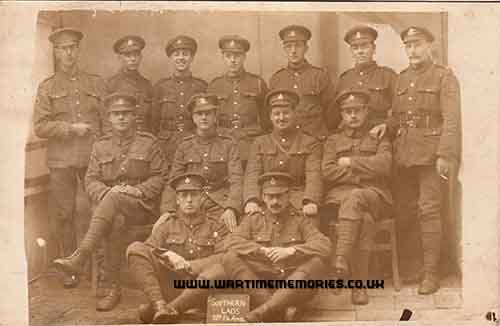
![Arthur [1914] with Jack who was killed on the the Somme](https://www.wartimememoriesproject.com/greatwar/images/ArthurKember [1914] with Jack (killed on the the Somme).jpg)
